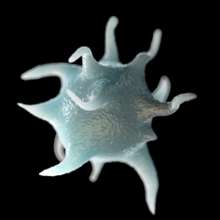Platelet biomechanics sheds light on coronary disease

The answer to a 20-year-old physiology question may offer clues for the treatment and prevention of thrombosis and its related conditions, as well as heart attacks.
Renhao Li, PhD, is a member of a research team that discovered how tiny, clot-producing blood cells called platelets respond to shear stress, the force exerted by blood on blood cells when it moves rapidly through a vessel or artery. Li is professor in the Department of Pediatrics, Division of Hematology and Oncology, at Emory University School of Medicine, and Aflac Cancer & Blood Disorders Center of Children's Healthcare of Atlanta.
The research will be reported in the Sept. 27 issue of Nature Communications, in a paper titled "Platelet clearance via shear-induced unfolding of a membrane mechanoreceptor."
To illustrate shear stress, Li uses a metaphor of a flowing river. "If you put a boulder in the middle of a river, the water exerts a force—shear—on that boulder," he says. "The stronger the current, the stronger the force on the boulder." The current speeds up if one could narrow the river channel; likewise, in the human circulatory system, blood flows faster when, for instance, vessels are contracted.
"There are three major components that determine thrombosis risk," he explains. "One is blood, the other one is vessel, and the third component is flow."
Understanding the interplay among these components, specifically how platelets respond to blood flow shear, is significant in terms of understanding a number of blood diseases, Li notes.
When a blood vessel is injured, platelets release clotting factors that plug the hole at the injury site and stop the bleeding. But clot formation also may be triggered if blood is flowing too quickly. These clots (emboli) are not good news. They impede blood flow to tissue, and may break off from the spot where they were formed to travel through the bloodstream where they get stuck, blocking blood from reaching the heart, lungs or other vital organs.
Medical researchers long ago established that platelets can respond to blood shear through a protein complex called GPIb-IX located on the platelet surface, but how this protein complex senses and responds to shear or force has remained a mystery for the past 20 years. Li and his colleagues recently found that, contrary to popular belief, a certain region within GPIb-IX is, in fact, structured. This so-called mechanosensory domain or MSD becomes unfolded on the platelet surface when certain protein molecules found in the plasma bind to GPIb-IX under blood shear and impose a pulling force on it. The unfolding of MSD sets off a complex chain of events and sends an intracellular signal into the platelet that results in rapid platelet clearance.
"Every day your bone marrow generates more than a billion platelets, and every day you clear the same number," Li says. "It's critical that your platelet count stays constant. Too few platelets can lead to a condition called thrombocytopenia and may cause spontaneous bleeding or stroke. In addition, cancer patients undergoing chemotherapy are likely to have damaged platelets and thrombocytopenia, too. Thus, identifying the molecular "switch" that triggers platelet clearance is important for designing new therapies to treat thrombocytopenia."
While the mechanism behind MSD unfolding-induced platelet clearance remains an open question, according to Li, his research provides a good starting point for further inquiry into the phenomenon.



















